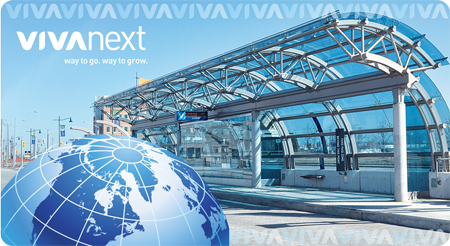One of the things we’re most proud of here is that our vivaNext rapid transit plan reflects the most current and leading edge design and technology there is. And I say that not just from pride, but because our project has always taken a knowledge-based approach to everything we do – from how we developed our rapidway overall, to the design of our curved glass shelters, to our construction methods. Before we make a decision, we always ask our experts, whether they’re engineers, architects or planners: what’s the best way to do this based on experiences in other cities and countries, where has it been done elsewhere, and what have others learned so we can make it even better?
Fortunately, we have access to opportunities to share information and lessons learned, including conferences which attract transit professionals from around the world. Although the sessions may sound pretty dry – conference workshops our experts have attended include “Light Railways and Busways as Key Driver to Sustainable Urban Development – the Swedish Experiences with Transit Oriented Development”, “Off-Board Fare Payment Using Proof-of-Payment Verification” and “Enhancing Neighbourhoods Through Streetcar Development in Paris, France” – this is how important ideas get debated and improved.
We have searched for best practices on what’s worked well elsewhere, including how to shape development through transit, how to move people quickly and inexpensively, what technology works best and so on. We look for practices that have been successful in circumstances similar to those here in York Region, including the existing built form of our communities, population densities, and traffic patterns. Obviously not all experiences are applicable here. But by sifting through the experiences of countries literally around the world, we have been able to design a program that we believe will meet our objectives of increasing transit ridership, shaping development through future growth, and benefiting everyone in York Region.
And the fact that vivaNext experts are now being asked to speak at conferences about what we’re doing here, means others around the world are looking at our project too. So we’ll keep learning, and fine-tuning, and bringing the best the world can offer in rapid transit to York Region


One reply on “Learning from the best around the world”
I have a few questions about the physical size of the Viva stations. Is there a standard sized station? What is the length (roughly) of the glass shelters and the length of the actual bus platforms themselves? What is the passenger capacity of each bus platform and shelter? How many bus bays does each ststion have or can multiple buses stop at a station simultaneously if so how many? Lastly, has Viva measured the peak hour capacity of the current stations and system (in passengers per hour per direction) and how is this capacity expected to grow to over time, especially as the Yonge Street and Highway 7 corridors fully build out? I am interested in comparing those statistics with the current Transitway system here in Ottawa.
Many thanks !
Fraser Pollock
DaleA: Hi Fraser,
Thanks for your questions. We’re checking our stats and will get back to you with some answers as soon as possible.